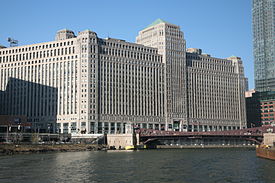After World War Two, American commerce escalated in ways unimaginable earlier in the century. The Chicago Merchandise Mart stands as one of the centers of that escalation, providing a venue for some of the period’s greatest thought leaders in commerce: Field, Montgomery Ward, Rosenwald and Wood (Sears, Roebuck and Company), Wanamaker, Filene, and Hartford (A&P).
Fittingly, the most recent face to face meeting of the W3C Web Payments Interest Group convened in the Mart on March 22, 2017. In attendance were representatives of merchant consortiums, credit card brands, as well as telecom and technology representatives. As the Interest Group has matured, its discussions have extended beyond payments to Web commerce more broadly. At this meeting, we discussed several topics that will shape our agenda through 2017.
Ted Guild (W3C) presented use cases for Connected Vehicle Payments, highlighting both the special aspects of vehicle initiated payments as well as some unique challenges in this area. Ted has proposed that we create a joint task force with the Automotive and Web Platform Business Group to deepen our understanding of these use cases.
Security in Web Payments is an on-going concern, and Ken Mealey (American Express) gave some explicit focus to the challenges in securing payments on the Web in “The Case for Greater Web Payments Security.” As merchants and card brands apply new security measures (such as EMV) to traditional card payments, payment fraud moves to areas unaffected by those measures. Ken recommended that the group devote more attention to tokenization. He also suggested that we develop relationships with external security focused groups like PCI, EMVCo, and FIDO Alliance, and work to provide educational material to users of the Working Group’s APIs.
Traditional retail transactions rely on receipts to provide a legal record of purchases. This record fulfills the needs of tax reporting, personal record keeping, expense reimbursement, applying for refunds, and other functions as well. Digital Receipts for Web Payments could fulfill these needs while adding the convenience of automated handling. David Ezell (NACS) presented potential scenarios for including receipt handling in the flows of Web Payments, as well as some of the currently available options for representing those receipts electronically. There was support in the group for the idea of merchants being able to return a digital receipt to a “payment app” as a follow-on to the Payment Request API.
Retail offers align consumers and merchants for mutual benefit: consumers get better deals, and merchants get more sales as well as more loyal consumers. The Digital Offers Community Group is exploring how to make Digital Offers work on the Web and with Web Payments. Linda Toth (NACS and Conexxus) presented the current state of the Community Group work, as well as highlights of the proposed Digital Offers Use Cases. To advance the discussion, Manu Sporny (Digital Bazaar) presented a demonstration of a potential digital offers system built using W3C recommendations.
Without regulations, chaos would rule in payments. Keeping up with what regulations apply and where they apply is the job of the Regulatory Landscape Task Force, chaired by Jean-Yves Rossi (Canton Consulting). Jean-Yves presented the current work of the task force and explored how to move that work forward.
At the end of the meeting, the Interest Group decided to pursue all of these topics in the coming months. Once again, the Mart provided a venue for new thought in commerce.

